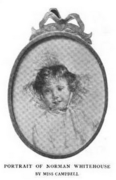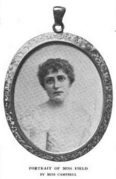Georgine Campbell (1861–1931) was a 19th-century American painter from Louisiana, specializing in miniature portrait painting. Trained in New Orleans and Paris, Campbell had the double distinction of being the first Southern woman who came to New York to make portrait painting a profession, and one who has earned a competency.[1] When the work began to tell on her eyes, she was obliged to limit her time spent on miniatures and alternate it with larger pieces. In the present day, her portraits of Ulysses S. Grant and Henry Morrison Flagler are part of the Smithsonian's collection at the National Portrait Gallery.
Early years and education
Georgine Campbell was born in New Orleans, Louisiana, in 1861. She was a daughter of Dr. George Washington Campbell, a descendant of the Scotch family of that name. Her father was one of the wealthiest and most influential men in the South,[2] where the family lived and had been social leaders all the way back to the times of Osceola and President Jackson.[3]
As a young girl, Campbell first studied with Francois Bernard, who alternated his time between New Orleans and Paris. She was his only pupil. He took her on trial for two months and kept her until she went abroad to study in Paris,[1] under Federico de Madrazo, to whom she attributed much of her success. During her absence, her father's plantations were three times under water, and she returned to find the great estate a swamp. In the midst of this trouble, her father died.[3]
Career

After her father's death, it became necessary for Campbell to support herself, and she turned to her art. Her first orders were from St. Louis after which she decided to come to New York, starting off with a few hundred dollars in her pocket, and three letters of introduction. The people named in the letters all died within the first year, but her income started to grow. She lived in a hotel until she bought a home on Madison Avenue from which the increasing noise drove her away. Campbell then lived with her mother and sister in an apartment overlooking Central Park where she had the space and quiet necessary for her work.[1] Campbell received favorable mention on several occasions when her pictures were exhibited, and in the World's Fair in New Orleans in 1883 and 1884, she received the blue ribbon.[2] When the work began to tell on her eyes, she was obliged to limit her painting in miniature and alternate it with larger pieces.[3] Campbell died in 1931.[4]
Subjects
Though doing a miniature now and then, Campbell at first confined her work largely to oil and pastel, during which period she painted four portraits of Senator Leland Stanford, followed by others of Senators William Morris Stewart, Joseph N. Dolph, George Hearst and Vance, as well as Chief Justice Stephen Johnson Field. and General Ulysses S. Grant. A letter from Colonel Frederick Dent Grant speaks of Campbell's portrait of his father as “an excellent likeness, and one of the best he has seen in oil.” An unsuccessful attempt was made by burglars to steal this valuable painting shortly after it was finished; they had cut it almost entirely from the frame when they were suddenly surprised and fled. In addition to this particular portrait for the family, she made six others: one for the late Senator Stanford, one for the Republican Club of Helena, Montana, and one for a prominent resident of Chicago. Others who sat for her were the two children of Colonel Frederick Dent Grant, whose portraits he took with him to the legation at Vienna; General Grant's wife, Julia Grant; Ida Marie Honoré, and the daughter of General Joseph Lancaster Brent of Baltimore. Additional portraits were painted of Cora Urquhart Brown-Potter, Elizabeth Wharton Drexel and Outerbridge Horsey. Others included Joseph William Drexel and his daughter, Elizabeth Wharton Drexel; a daughter of Mr. William Kissam Vanderbilt; a nephew of Mrs. Cornelius Vanderbilt; Miss Fanny Field; Mary Ball, the mother of Mrs. Washington, taken from a water color in possession of Mrs. Benjamin S. Storey, a great-niece of General Washington; and two children of Jacob Perkins, of Cleveland, Ohio, who are represented taking five o’clock tea on the lawn in front of the house;[3]
General Ulysses S. Grant sat for Campbell. A letter from Colonel Frederick Dent Grant speaks of Campbell's portrait of his father as “an excellent likeness, and one of the best he has seen in oil.” An unsuccessful attempt was made by burglars to steal this valuable painting shortly after it was finished; they had cut it almost entirely from the frame when they were suddenly surprised and fled. In addition to this particular portrait for the family, she made six others: one for the late Senator Stanford, one for the Republican Club of Helena, Montana, and one for a prominent resident of Chicago.[3] Campbell's portraits of Henry Morrison Flagler and General Grant are part of the collection of the Smithsonian's National Portrait Gallery.[4][5]
Gallery
-
Portrait of Thomas Lloyd Whorton
-
Portrait of Norman Whitehouse
-
Portrait of Dr. William Argyle Watson
-
Portrait of Fanny Field
-
Portrait of Joseph Drexel
-
Portrait of Martha Codman Karolik
References
- ^ a b c Dodd, Mead and Company 1904, p. 57, 53.
- ^ a b Willard & Livermore 1897, p. 147.
- ^ a b c d e Art Interchange Company 1894, p. 107-08.
- ^ a b "Ulysses Simpson Grant". National Portrait Gallery. Retrieved 4 March 2017.
- ^ "Henry Morrison Flagler". National Portrait Gallery. Retrieved 4 March 2017.
Attribution
 This article incorporates text from this source, which is in the public domain: Art Interchange Company's The Art Interchange(1894)
This article incorporates text from this source, which is in the public domain: Art Interchange Company's The Art Interchange(1894) This article incorporates text from this source, which is in the public domain: Dodd, Mead and Company's The Bookman (1904)
This article incorporates text from this source, which is in the public domain: Dodd, Mead and Company's The Bookman (1904) This article incorporates text from this source, which is in the public domain: F. E. Willard & M. A. R. Livermore's American Women: Fifteen Hundred Biographies with Over 1,400 Portraits : a Comprehensive Encyclopedia of the Lives and Achievements of American Women During the Nineteenth Century (1897)
This article incorporates text from this source, which is in the public domain: F. E. Willard & M. A. R. Livermore's American Women: Fifteen Hundred Biographies with Over 1,400 Portraits : a Comprehensive Encyclopedia of the Lives and Achievements of American Women During the Nineteenth Century (1897)
Bibliography
- Art Interchange Company (1894). The Art Interchange. Vol. XXXII (Public domain ed.). Art Interchange Company.
- Dodd, Mead and Company (1904). The Bookman. Vol. XIX (Public domain ed.). New York: Dodd, Mead and Company.
- Willard, Frances Elizabeth; Livermore, Mary Ashton Rice (1897). American Women: Fifteen Hundred Biographies with Over 1,400 Portraits : a Comprehensive Encyclopedia of the Lives and Achievements of American Women During the Nineteenth Century (Public domain ed.). Mast, Crowell & Kirkpatrick.
External links
 Media related to Georgine Campbell at Wikimedia Commons
Media related to Georgine Campbell at Wikimedia Commons







